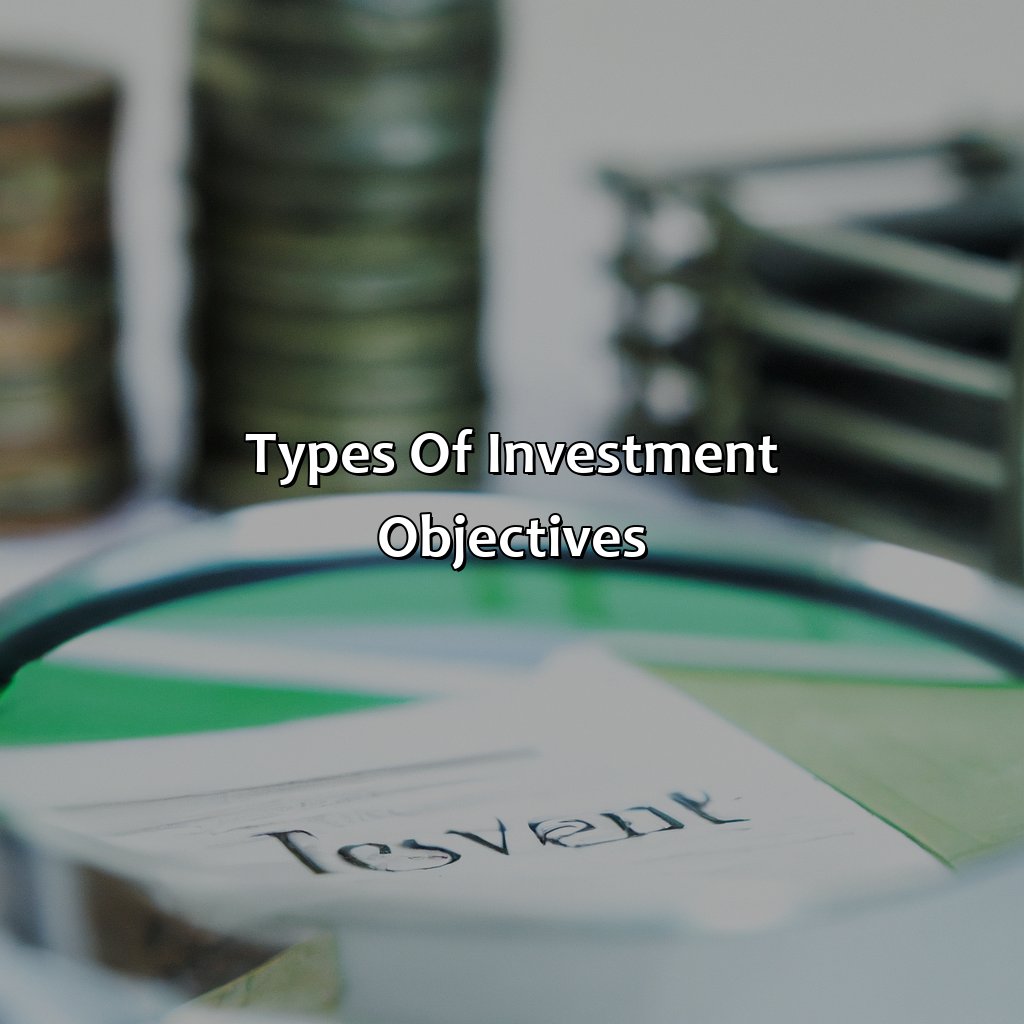What Is An Investment Objective?
Key Takeaway:
- Investment objectives are goals that investors set for themselves or their businesses to achieve through investing, such as generating income, achieving growth, or preserving capital.
- Setting realistic investment goals is crucial to achieving success in investing, and having a roadmap for investing can help investors stay on track and make informed decisions.
- Investors should align their investments with their personal or business targets, taking into account factors such as risk tolerance, investment horizon, and market conditions.
Are you considering investing, but unsure of what your objectives are? This article will provide an overview of investment objectives, and explain why understanding them is essential for successful investing.
Understanding Investment Objectives
Investment Objectives – A Professional Insight
Investment objectives refer to the financial goals of an investor. They are the primary drivers that dictate investment decisions, such as the selection of asset classes, risk tolerance, and holding period. Investors select their objectives based on their current and future financial needs, such as a retirement fund or short-term wealth accumulation.
It is crucial to establish clear objectives, as they provide direction and focus for investment decisions. Common investment objectives include capital growth, income generation, and capital preservation. Investors may select one or a combination of these objectives to fulfill their financial needs.
Additionally, investors must assess their risk tolerance before selecting an investment objective. Risk tolerance refers to how much risk an investor can take on before feeling uncomfortable. It is crucial to align the investment objective with the investor’s risk tolerance to ensure they can handle potential losses.
A true fact to consider is that investment objectives can change over time based on changes in financial needs, market conditions or personal circumstances. According to a study conducted by Vanguard, as of 2019, 22% of investors changed their investment objective to something more conservative within the past year.

Image credits: retiregenz.com by David Duncun
Definition of Investment Objectives
Investment Objectives refer to the financial goals an individual or organization aims to achieve through investments. These objectives may differ based on factors like risk tolerance, time horizon, and financial position. The most common investment objectives include capital preservation, income generation, and long-term capital appreciation. It is crucial to define clear investment objectives before making investment decisions to avoid losing money.
Investors may have specific investment objectives such as purchasing a retirement home or funding their children’s education. The investment objectives should align with the investment strategies chosen by the investor, which may include selecting suitable assets, diversifying their portfolio, and adjusting their investments as market conditions change. The investment objectives must be measurable and achievable, which will help investors review and analyze their investment performance over time.
In addition to selecting suitable investment vehicles and strategies aligned with their investment objectives, investors must regularly review and adjust their investment portfolio. They can also seek help from investment advisors to make informed and profitable investment decisions.
Pro Tip: When selecting investment objectives, it is best to focus on long-term financial goals rather than immediate gains. This approach will minimize the impact of short-term market fluctuations and help investors achieve sustainable growth over time.

Image credits: retiregenz.com by David Washington
Importance of Investment Objectives
Understand the importance of investment objectives.
Set realistic goals.
Make a roadmap for investing.
Align investments with personal or business targets.
This will lead to successful investments. These sub-sections will guide you. They will help you set correct investment objectives. They will provide information to make informed investment decisions.

Image credits: retiregenz.com by Adam Arnold
Setting Realistic Investment Goals
Investment objectives setting guide to achieve realistic financial goals. Goals should be aligned with the investor’s risk tolerance, timeline, and financial situation. Determine a clear objective, developing a strategy, and measure progress towards their goals using data-driven insights and expert advice.
When setting investment goals, it is crucial to keep the SMART criteria in mind. The goal must be specific, measurable, achievable, relevant, and time-bound. Investors should also consider diversification of assets and different investment options available. Realistic investment goals require consistent efforts and determination.
Furthermore, tracking performance regularly can help investors make any necessary adjustments along the way. And if market changes alter their trajectory towards their intended outcome or cause significant underperformance? Then review it regularly but not try to time or chase the market by changing objectives too frequently.
Call us today to discuss your investment strategies for achieving your financial goals based on real data-driven insights from our team of expert advisors while avoiding the Fear of Missing out!
Before you invest, make sure you have a clear roadmap – otherwise, you might as well be driving blindfolded.
Establishing a Roadmap for Investing
Establishing a clear and concise Investment Objective is crucial in creating a roadmap for successful investing. Mapping out your financial goals, risk tolerance and investment timeline allows investors to tailor their investment strategies accordingly. By identifying specific objectives, investors can minimize unnecessary risks and maximize potential returns.
It’s important to note that establishing an Investment Objective does not mean that it can’t be changed or adjusted as circumstances change. It should serve as a guideline but not rigidly adhere to it. Investing requires flexibility, adaptability and a willingness to continuously evaluate your investment strategy against your Investment Objectives.
Pro Tip: Reviewing your Investment Objectives regularly helps you stay on track towards achieving long-term financial goals.
Make your money work for you, so you don’t have to work for it – unless of course, your business target is to never retire!
Aligning Investments with Personal or Business Targets
Every investment, whether personal or for a business, must have a designated objective to align with its intended purpose. This ensures that the investments made are tailored to achieve specific targets. By having clear objectives, investors can make informed decisions and choose suitable investment options according to their needs.
Investors align their investments with their personal or business targets by setting defined objectives that cater to their requirements. The objective may be long-term wealth creation, short-term gains, growth opportunities, or hedge against inflation. By doing so, they can efficiently allocate resources towards achieving those purposes.
It is essential to comprehend the significance of setting an investment objective that aligns with personal or business goals. An investor should evaluate risk tolerance while keeping in mind the expected outcome of the investment. Clear objectives help avoid unwarranted risks and provide direction in choosing an appropriate investment option.
There was a company that diversified into multiple sectors without aligning its investments with its vision and mission statement. The firm lost focus on its core competencies and faced severe financial loss due to poor returns on over-diversified investments. This scenario showcases how crucial it is to align investments with the company’s objectives.
Get to know the different types of investment objectives before you accidentally invest in a company that makes fidget spinners.
Types of Investment Objectives
Discover the different types of investment goals! This section will explore the multiple options available. Learn about the three main categories: Income-Oriented Objectives, Growth-Oriented Objectives and Capital Preservation Objectives. Reach your desired investment result!

Image credits: retiregenz.com by James Woodhock
Income-Oriented Objectives
Investment objectives that prioritize generating income are commonly referred to as yield-based investment objectives. Yield-based investment goals include generating regular payouts in the form of dividends, bonds, or rental income from properties. These objectives target investors who seek to generate steady cash flow over time and might be less concerned about growth. Such portfolio allocations may consist mostly of fixed-income securities or investments in high-income-yielding sectors like utilities or real estate trusts. Investments in dividend-paying stocks can also fit this objective with the potential for long-term capital appreciation in addition to a reliable income stream.
A balanced approach may combine yield-oriented investments with other objectives to achieve a diversified and personalized investment portfolio.
According to a Forbes article by Rob Berger, “There is no one-size-fits-all answer when it comes to investing.”
Growing your savings is like growing a plant: you need to nurture it, water it, and make sure it gets plenty of sunlight – and if all else fails, just pray it doesn’t die.
Growth-Oriented Objectives
Investment objectives that aim toward capital growth are commonly referred to as goals oriented towards revenue enhancement opportunities. These investment objectives focus on maximizing returns in the long run and emphasize investing in assets with a higher potential for growth, such as equities or stocks. It is essential to understand that while these objectives may offer favorable returns, they are also accompanied by volatility, risks, and market fluctuations. The primary aim of Growth-Oriented Objectives is to create wealth over time via regular investments into diversified portfolios.
Moreover, Growth-Oriented Objectives have high-risk tolerance levels as compared to other investment goals like income-oriented or capital protection objectives. For instance, investors with a higher risk appetite could opt for Growth-Oriented Objectives as it can offer them better returns by investing in high-return equity securities. Although this objective requires constant monitoring and reassessment of an investor’s portfolio against their financial targets.
It’s noteworthy that Growth-Oriented Objectives have been on the rise in recent years because of exciting tech company IPOs or an evolutionary era characterized by advancements in Artificial Intelligence (AI) and Blockchain Technologies.
According to a recent survey by Forbes, 89% of investors consider wealth maximization via capital growth as their priority end goal when considering various Investment options.
Saving for a rainy day? More like saving for a hurricane with these capital preservation objectives.
Capital Preservation Objectives
Investment goals can differ depending on an individual’s financial situation and the level of risk they are willing to take. One such investment goal is the preservation of capital, where investors seek to protect their initial investment amount from loss. This objective is essential for investors who want to avoid the risks associated with market fluctuations and preserve their capital without compromising on gains.
To achieve this objective, investors may choose to invest in low-risk investments such as bonds, treasury bills or certificates of deposit (CDs), which have a lower rate of return but are less volatile. Diversifying investments across different assets classes like stocks, real estate, commodities or currencies also reduces the risk by spreading the investment across several opportunities.
Smart planning and thorough research can help investors achieve their capital preservation goals while keeping the risk minimal. It’s crucial to keep a close eye on market trends and shifts that could impact investments negatively from time to time.
Investment advisors state that preservation of capital preserves buying power and allows individuals not to chase performance risky growth. Capital Preservation Objectives often follow Preservation of Income objectives since income can contribute significantly to capital preservation without affecting its principles.
According to Charles Schwab, “If you’re investing for a specific goal—for example, a college education for your children—you might focus more on staying ahead reasonably than preserving capital.”
Choose your investment objectives wisely, because unlike exes, they can haunt you forever.
Factors Influencing Investment Objectives
To decide your investment objectives properly, taking into account elements such as risk tolerance, investment horizon, and market conditions, consider and evaluate them all. This way, you can get a better grasp of your investment goals and establish an investment strategy that corresponds to your financial requirements and objectives.

Image credits: retiregenz.com by James Duncun
Risk Tolerance
Investment Risk Profile is a critical factor in determining investment objectives. To put it simply, it’s an assessment of how much risk one can bear while making an investment. An investor with a high tolerance for risks may choose investments that give higher returns but may involve significant risks. In contrast, an investor with low risk tolerance would opt for safer investment schemes with lower returns.
Considering the risk profile in investment decisions could impede the negative consequences of unexpected catastrophic events and unfavorable market conditions. It’s essential to have a thorough understanding of one’s financial goals and personal circumstances to make informed investment decisions.
It’s crucial to note that there are no universal guidelines for determining an individual’s applicable risk level. Therefore, it’s recommended to consult with certified advisors if you’re unsure about your risk tolerance level.
The primary recommendation would be to do thorough research on various investment options before jumping into anything blindly. Furthermore, starting small and gradually increasing investments once you have more knowledge on the subject is also advisable. One can also consider diversifying their portfolio by investing in different sectors like stocks, bonds, real estate, etc., which could minimize the overall risk involved in any single sector’s ups and downs.
Your investment horizon should be longer than a Game of Thrones plot line, or you’ll be left with nothing but a disappointing finale.
Investment Horizon
The time frame in which an investor expects to achieve their financial objectives, whether it is short-term or long-term, is known as the temporal dimension of investing. It is referred to as ‘Investment Duration.’ Investment horizons typically vary depending on the investor’s risk profile and desired return on investment. Investors with a longer investment horizon can afford to tolerate higher levels of risk and volatility in their portfolios, whereas those with shorter horizons may prefer lower-risk investments.
The duration of an investment dictates its suitability for a given investor. Long-term investors must consider market trends while making such decisions because they are frequently influenced by economic growth cycles. Equity investments, for example, may be beneficial over the long term but are subject to greater price volatility than fixed-income securities. A short-term investment has a smaller duration, which can provide stability to the portfolio during choppy markets but limits potential returns.
Not only does the lifespan of an investment influence the return on investment, but it also has an effect on tax consequences and fees incurred by mutual funds or advisory services utilized by an investor throughout their journey. In general, shorter-term trading activity incurs more transaction fees and capital gains taxes while lengthier holding periods result in deferred taxes and required minimum distributions.
A common problem that arises when managing one’s own portfolio is predicting how certain assets will perform over time. Because each asset class behaves differently under a variety of market scenarios and economic conditions, forecasting becomes much more challenging with longer-time horizons. Long-term investors should expect that total returns from their portfolios would fluctuate depending on different time frames’ performance and changes in interest rates.
As with all aspects of investing, unexpected events can cause substantial financial losses during any time horizon—an investor who purchased stocks before significant market declines may suffer severe losses extending into retirement years if it was a long term investment goal. Therefore, portfolios must maintain balance across various sectors based upon consistency strategies for minimizing downside volatility returns.
Investing during a recession is like trying to throw a dart at a moving target, blindfolded, and with your non-dominant hand.
Market Conditions
Investment Objectives are influenced by the latest trends and conditions of the financial landscape. The dynamics of Market Variables are evaluated based on their impact on long-term investments. These elements could range from interest rates, inflation, volatility, geopolitical risks, and macroeconomic factors.
Market conditions play a vital role in determining what investment approach is appropriate. For example, if the economy is stable and there is an upward trend, growth investments may be favored over conservative approaches. However, if the market fluctuates due to political or economic uncertainty, hedging strategies might be more appropriate to protect the investment portfolio.
It’s worth noting that market variables directly affect how assets perform and influence investors’ diversification methodology to control risk exposure. To make informed decisions based on these variables’ nature requires expertise in analytical skills, background knowledge of economics and finance theory, and efficient methods for analysing troves of data sets.
According to Investopedia’s article ‘Introduction To Investment Objectives,‘ investors must have a clear goal when making investment decisions to achieve long-term finances successfully.
Overall understanding how market conditions impact different asset classes is essential for having a diversified portfolio aligned with an investor’s unique objectives.
Let’s hope your investment plan is better than your Tinder profile.
Creating an Investment Plan Based on Objectives
Creating an Investment Strategy Focused on Objectives
Investment objectives are the goals an individual or organization aims to achieve through investing. These objectives vary based on factors such as risk tolerance, income, and personal goals. Creating an investment plan based on objectives entails defining clear investment goals and devising a strategic plan to achieve them.
To create a well-rounded investment plan based on objectives, it is essential to assess an individual’s current financial standing. Develop an understanding of current assets, liabilities, income, and expenses. By doing so, an individual can calculate their net worth and establish clear objectives that fit their financial situation.
Once a clear set of investment objectives has been established, it is time to consider investment strategies that fit the defined objectives. An investor may want to consider investing in stocks, bonds, or real estate or alternative assets such as commodities or private equity. Each investment vehicle has a unique set of risks and rewards that must be weighed to align with the goals.
When setting investment objectives, it is essential to consider a time horizon. Recognize the amount of time available to reach investment goals and how this timeline affects the investment portfolio’s composition. For example, an investor with a longer time horizon may be able to take on more risk than someone who needs to achieve investment goals in a shorter period.
To achieve investment objectives, it is also essential to have a clear understanding of the costs associated with investment strategies. High fees can significantly impact investment returns and undermine the effectiveness of an investment plan established to meet specific objectives. An investor should make an effort to minimize the impact of fees and taxes through a well-thought-out investment strategy.

Image credits: retiregenz.com by Adam Arnold
## Example Response:
Five Facts About Investment Objectives:
Investment objectives are goals that an investor sets for the expected return on investment and the level of risk that they are willing to take. (Source: Investopedia)
Investment objectives are important in helping investors to make informed decisions that align with their financial goals. (Source: Fidelity)
Common investment objectives include growth, income, capital preservation, and speculation. (Source: The Balance)
Investment objectives can vary depending on factors such as age, income level, and risk tolerance. (Source: Charles Schwab)
Setting a clear investment objective can help investors to stay on track and avoid making impulsive financial decisions. (Source: Forbes)
FAQs about What Is An Investment Objective?
What is an investment objective?
An investment objective is a specific financial goal that an investor wants to achieve through their investment. It could be wealth preservation, regular income, capital appreciation, or a combination of these goals.
Why is it important to have an investment objective?
Having a clear investment objective helps investors avoid making impulsive, emotionally driven decisions that could negatively impact their investment portfolio. It helps them make informed decisions that align with their financial goals, risk tolerance, and investment timeline.
How do you determine your investment objective?
To determine your investment objectives, you need to evaluate your financial situation, risk tolerance, investment goals, and investment timeline. A financial advisor or investment professional can help guide you through this process and provide recommendations based on your unique circumstances.
Can investment objectives change over time?
Yes, investment objectives can change over time due to changes in your financial situation, investment goals, and risk tolerance. It is important to regularly review your investment objectives to ensure they are still aligned with your current circumstances and financial goals.
What are some examples of investment objectives?
Some examples of investment objectives include capital preservation, generating regular income, achieving long-term growth, funding retirement or education expenses, and achieving a specific financial goal, such as buying a house or starting a business.
How do investment objectives impact investment decisions?
Investment objectives play a crucial role in determining the types of investments to include in a portfolio, the level of risk to take on, and the investment timeline. Investment decisions should always align with the investor’s investment objectives to achieve their financial goals and minimize risk.
 Checkout this IRS Loophole
Checkout this IRS Loophole 
